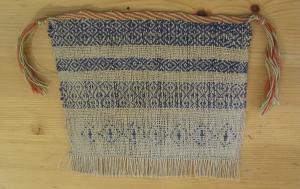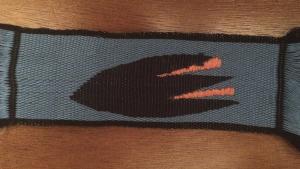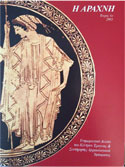Reconstruction of decorative patterns depicted on garments in wall-paintings from Akrotiri, Santorini, using the warp-weighted loom and tablet-weaving
In 2005, during her Masters on textile production in Akrotiri, Thera, Stella Spantidaki carried out a series of weaving experiments in order to better understand the techniques that may have been used to create decorative patterns depicted on garments in wall-paintings of the site.
1. The same lozenge pattern has been woven on the warp-weighted loom using a twill weave and additional weft techniques.
2. At the same time, she experimented with tablet weaving for the creation of several simple, geometric patterns using linen and wool threads.
3. Finally, she reconstructed a crocus flower design depicted on a band on the garment of the Goddess on a wall-painting in Xeste 3, Akrotiri. The band has been woven using a combination of double faced weave and an additional weft. The double faced weave is the simplest technique allowing the creation of complex decorative patterns and the created fabric has two sides, each of which can be used as the right side. The reconstruction has been carried out under the supervision of Claire Gérentet, specialised in historical reconstructions using tablet weaving.
Publications:
Spantidaki S. 2008 Preliminary results from the reconstruction of Theran textiles. In C. Alfaro and L. Karali (eds.) Purpureae Vestes II. Textiles and Dyes in Antiquity. Proceedings of the second International Conference on Textiles and Dyes of the Mediterrannean in the ancient world, Athens, 24-26 November 2005. University of Valencia, 43-48.
Σπαντιδάκη Σ. 2009 Πρώτα αποτελέσματα από την ανακατασκευή θηραϊκών υφασμάτων. In Χ. Λούκος, Ν. Ξιφαράς and Κ. Πατεράκη (eds.) Ubi dubium ibi libertas. Τιμητικός Τόμος για τον Καθηγητή Νικόλα Φαράκλα. Ρέθυμνο, Εκδόσεις Φιλοσοφικής Σχολής Πανεπιστημίου Κρήτης.
- Log in to post comments





